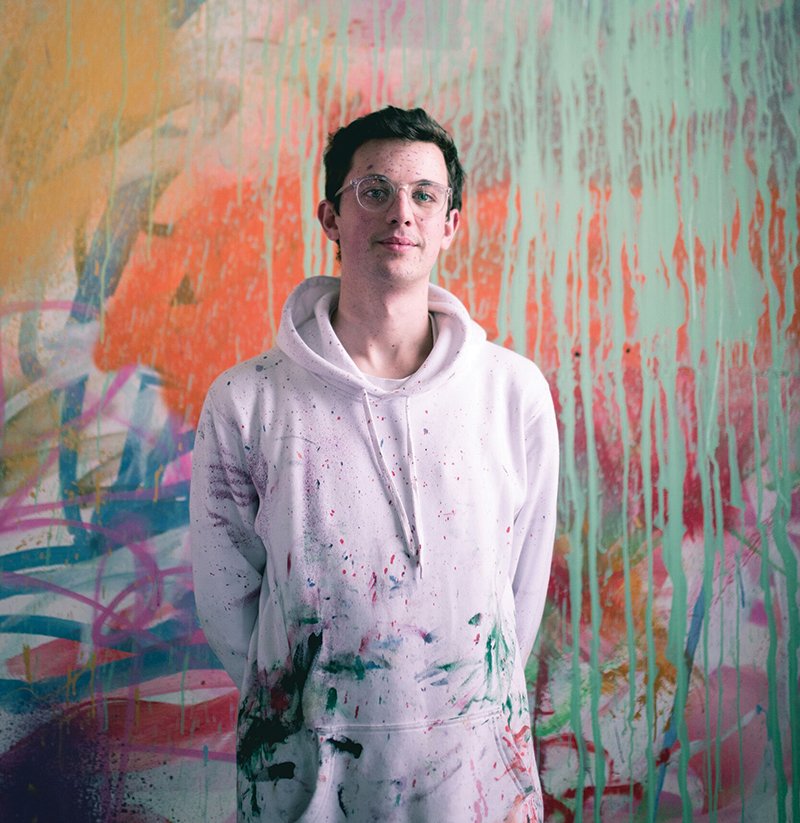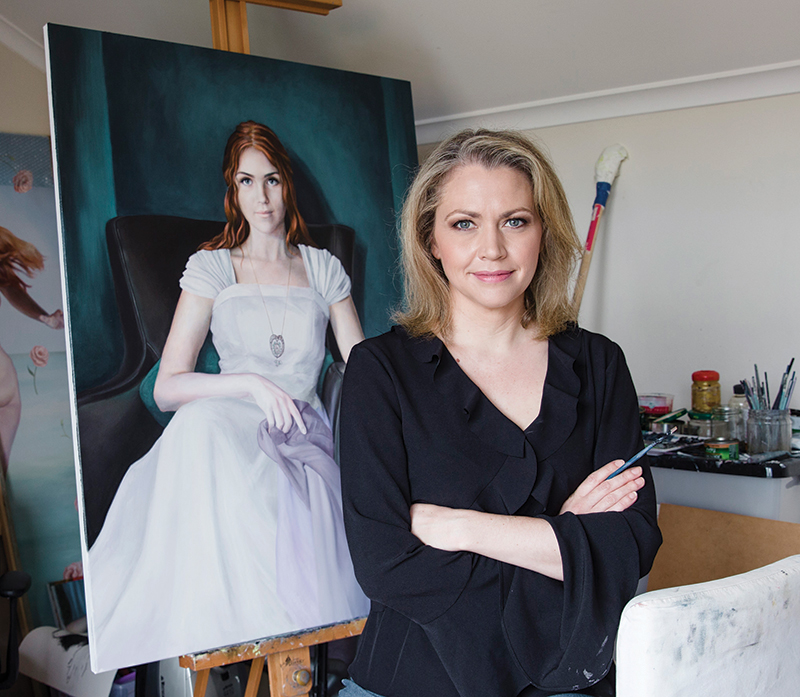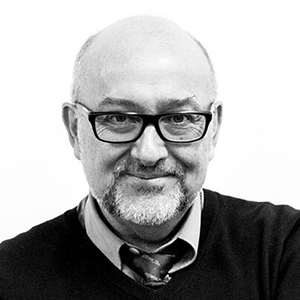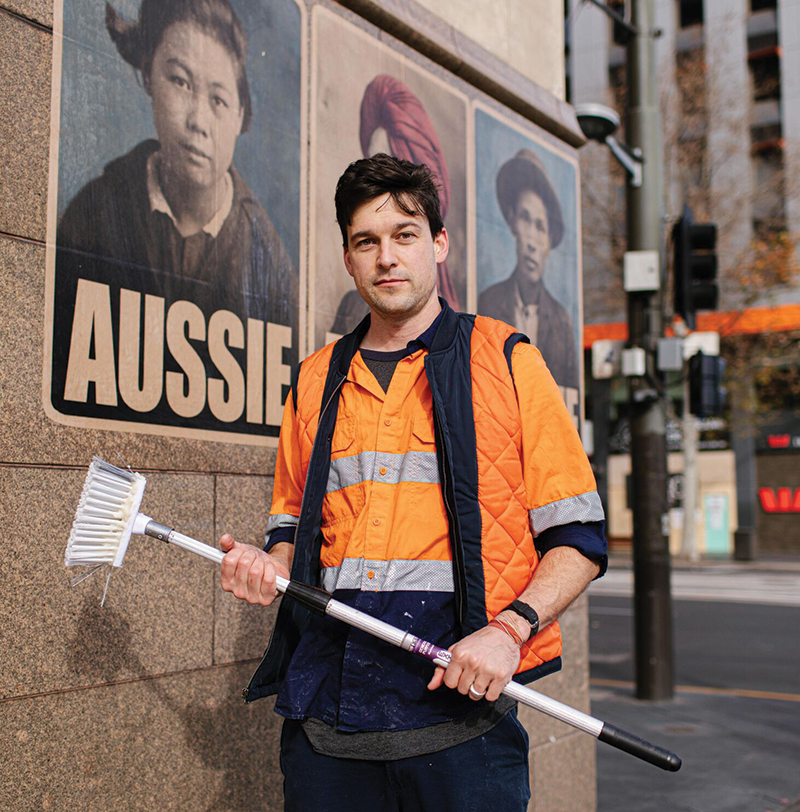What was once painted over or removed by local authorities is now more often recognised and cultivated by state and local governments through supportive policies and events such as the Oi You! Urban Art Festival and Wonderwalls Port Adelaide. Local businesses are commissioning their own street art installations for their buildings, adding colour and life to the public spaces they occupy.
One of the reasons councils and property owners have adopted a more supportive stance towards street art is the economic benefits it can bring. Melbourne’s graffiti-filled laneways have become tourist attractions in their own right. There’s growing recognition that street art can make cityscapes and urban spaces more appealing. A lot of Adelaide’s street art takes the form of legally commissioned murals rather than illegal acts of rebellion, which graffiti is often associated with.
 UniSA Visual Arts Honours graduate Dave Court is known for his large-scale mural paintings. Photo by Morgan Sette.
UniSA Visual Arts Honours graduate Dave Court is known for his large-scale mural paintings. Photo by Morgan Sette.
UniSA Visual Arts Honours graduate Dave Court has a range of experience with large-scale mural paintings.
"(Murals) and commissioned work are great for me because I can make a living painting walls and also get to add colour to people’s commute,” he says.
One of his most recent and his largest mural to date was the Adelaide City of Music mural near Morphett Street bridge. The work celebrates the cultural history and success of Adelaide’s music scene, following its designation in 2015 as a UNESCO City of Music.
Watch a documentary about the making of the Adelaide City of Music mural.
“This is the largest mural wall in Adelaide,” Court says. “It was a big commission, but it wasn’t just good for me, it’s great for Adelaide’s music industry and the city at large. I think it has a great effect – it adds more colour and life to the city and studies show street art is great for the economy. It’s also great that there’s this piece of art that celebrates our amazing local music scene. I see what I do as mural painting or just painting on walls rather than street art or graffiti – but I feel like all of these things cross over and share some similar ideas and goals.”
It may sound counterintuitive, but street art can also reduce vandalism and graffiti.
 UniSA alumna Yvonne East says public art can reduce the likelihood of vandalism. Photo by Yasmin Mund.
UniSA alumna Yvonne East says public art can reduce the likelihood of vandalism. Photo by Yasmin Mund.
UniSA alumna Yvonne East understands the effects public art has on the space it occupies. Her first major public mural was commissioned by the Victor Harbor council in 2008. East secured a contract to work on a project that would cover toilet blocks in the town centre that had a constant problem with vandalism.
“The local council thought a public art installation might help stop this,” East says. “I worked on a mural about the history of whaling in Victor, looking at it from an environmental tourism perspective. Both myself and the council were worried about it being vandalised after completion but the response to it was really positive. It’s been there 11 years and looks as good as new – it’s hardly been touched.”
Street art also adds cultural value to a city, reinforcing a sense of creativity and engagement.

In a recent paper on street art and augmented reality, UniSA Research Professor for Design and co-manager of the Australian Research Centre for Interactive and Virtual Environments (IVE) Ian Gwilt argues that street art changes our relationship with a city.
“Street art not only shapes our sense of self, it changes an environment from a sense of space to a sense of place,” Prof Gwilt says. “It humanises a space and can make people feel a greater sense of belonging to an environment.”
He says whether it is an opportunistic act or by invitation, street art creates a “site specific” response to a public space.
The location of an artwork also has a lot to do with how an artistic piece is read.

Anne & Gordon Samstag Museum of Art curator Gillian Brown says where an artist chooses to display a work, or where a work is commissioned, has a lot do with the context and understanding of the work.
“In terms of street art, to have someone do something on the street compared to in a gallery — I think that artform loses some of the nuance if it’s contained within a building,” Brown says.
“Being out in public in an unavoidable way, as well as the illegality of it, all form a part of the work.
“The same thing happens the other way when artists are offered work from the council in a space commissioned for street art. Every work is affected by where it is, you wouldn’t read a sculpture out on the street the same as you would in a gallery.”

The director of the Samstag Museum of Art, Erica Green, says this raises questions around the value of commissioned street art compared to tagging – the act of writing a nickname or mark on a surface, often illegally.
“It’s important to distinguish between what we call street art and what’s been sanctioned by council in comparison to tagging,” Green says.
“Increasingly the idea of painting murals in the street and around the city is a very established practice.
“The complexity is that a lot of artists who produce street art started with tagging, which is a topic that isn’t discussed as much.”
That was the case for local street artist Seb Humphreys. Transitioning from graffiti artist to commissioned street artist has given him a unique perspective. He says he reached a pivotal point when he was 10-years-old and the “city became (his) playground”.
“The lines between ownership of private property became blurred – I could exist anywhere,” Humphreys says. “Instead of drawing on a piece of paper I began to draw on walls, to paint on trains, always daring to dive deeper into my imagination and then express it as best I could. I learnt to paint at night – it’s an amazing feeling to paint where you’re not meant to paint, in a place you’re not meant to be, in a time when nearly everyone else is asleep.”
Signifying the legitimisation of his work, Humphreys has moved from illegal street art into public art, completing his first major public sculpture at George Whittle Reserve in Prospect earlier this year. Officially opened in October, it is a multi-functional artwork – part playground, part skatepark. However, this opportunity wouldn’t have been possible without first honing his craft on the street.
“It’s been a dream of mine to extend my practice into public sculpture and I have been gradually building the technical know-how and experience over the last few years,” Humphreys says.
Street art not only affects the space it occupies and the cityscape, but also the people who see it.
While we often consider the importance of how viewers understand a piece of art, some of the best street art asks the viewer to question their understanding of themselves.
 Street artist Peter Drew is known for his “Real Australians Say Welcome” and “Aussie” campaign posters. Photo by Wade Whitington.
Street artist Peter Drew is known for his “Real Australians Say Welcome” and “Aussie” campaign posters. Photo by Wade Whitington.
One of Adelaide’s most accomplished street artists, Peter Drew, is known for using his talents to bring controversial issues to the forefront of social dialogue in Australia.
“I like to exhibit my art on the street because public space is a great equaliser,” Drew says.
He recently released a memoir, Poster Boy, where he reflects on his art and his family and the reasons behind his work. He asks big questions about national identity, politics and how we treat each other and asks viewers of his work to question these themes themselves.
“I realised if I was going to do posters, everybody sees them, so it’s not a bad idea to talk about things (issues) that everybody’s thinking about.”
Traditional street art often has a political or social agenda and Drew’s work reflects this. This is at the core of traditional street art but isn’t necessarily present in commissioned murals. Drew says street art is a conflict between the value of freedom of expression and private property.
“Graffiti and street art are this pocket where those two things clash,” he says. “You go out into public space and there’s something natural about it – that you should be able to express yourself on the street. That conflict is core to what makes graffiti and street art interesting.
“If you remove the conflict and just make it about murals then it’s not really the same thing. I love murals, I love all public art, but street art’s always got to have that core element which will always be illegal and will always upset some people because that’s what makes it interesting and dynamic.”
Humphreys takes a different view and says contemporary muralism is about humans interacting with their environment as much as the art itself. He says that street art simultaneously assimilates and recreates the city environment it exists within.
“(Murals) exist in a living breathing area that will change over time, and indeed the artwork will change: it will be in shadow, in glaring sun, in a soft sunset, it will fade over time and it could be painted over the next time you walk past it,” Humphreys says.
“Public artworks become part of the world we live in every day, they create a story out of the streets we walk down, a conversation between the buildings, they offer something to everyone and are owned by no one.”
Ultimately, street art’s transition from something illegal, forbidden, into something encouraged and supported by its traditional enemies signifies both an entry into the mainstream and a sense of validation.
It also raises questions about control of public and private property and who owns street art. It provides a vehicle for people to express themselves and adds character to a place, as well as affecting those who view it in various ways.
Street art is good for the economy and can add vibrancy to a city but we must accept that the very nature of the artform means it can never be fully controlled and will never be confined to a certain area.
Whatever you think of it, in an otherwise featureless urban environment, graffiti is a sign of life.
FIND OUT MORE
Adelaide: City of Music mural project
Australian Research Centre for Interactive and Virtual Environments
Samstag Museum of Art